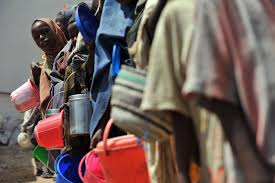Kenya says 800,000 starving are in need of food aid

The National Drought Management Authority (NDMA) has confirmed that at least 800,000 Kenyans in 23 counties need food aid because of the poor performance of 2018 short spots of rain.
The government agency warned that if the weather situation does not improve in March, the number could rise to 1.1 million because of the additional people in marginal agricultural counties.
“Sh34.2 billion is needed for intervention measures in relation to the current food security situation,” said Mr Sunya Orre, NDMA’s director of technical services.
Mr Orre, who was speaking on Friday when he released the food and nutrition security assessment report for the 2018 short rains and 2019 long rains, said despite the overall food security in the country remains stable compared to the same period in 2017, the situation has deteriorated in pastoral and marginal agricultural areas.
TOUGH FEBRUARY
The situation worsened in February 2019 after the inadequate performance of the October-December 2018 short rains.
Already, the NDMA has disbursed Sh75.7 million to affected households since the beginning of the year.
Garissa and Wajir counties have already received Sh10.4 million and Sh7.4 million respectively while requests for Tana River, West Pokot and Turkana counties are being processed.
“Additional funds have been released for drought shock-responsive cash transfers under the Hunger Safety Net Programme. A total of Sh.57.6 million was released to 21,344 households in Turkana and Wajir counties based on vegetation condition index thresholds for January 2019,” he said.
CASH TRANSFERS
Under the regular bi-monthly cash transfers, Mr Orre said NDMA has released a further Sh541 million from the government to 100,000 vulnerable households in Marsabit, Turkana, Wajir and Mandera counties where every household received Sh5, 400.
The authority is closely monitoring the drought situation across the country as well as the onset, distribution and performance of the 2019 March-May long drops of rain.
The food security assessment was conducted by the Kenya Food Security Steering Group which is a multi-agency body comprising government departments, UN agencies and non-governmental organizations dealing with food and nutrition security.
SELL LIVESTOCK
A senior livestock program coordinator from Food and Agricultural Organisation Piers Simpkin urged farmers to take advantage of the current livestock prices which were expected to rise if the drought continued.
“The projected average rains are expected to regenerate forage and water resources by late March to early April hence improving livestock productivity. I advise farmers not to wait to sell off their animals during the drought period when prices are low, but should instead take advantage of the current high market prices,” said Simpkin.
The Kenya Food Security meeting team will for the next six months monitor high malnutrition levels, crop pests and diseases, livestock disease outbreaks, impacts of programmes and interventions.
Daily Nation